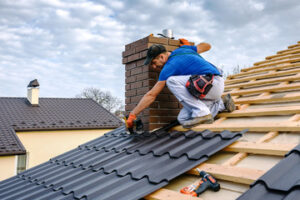Pest Control Stuart is a comprehensive approach that focuses on preventing pests from entering your home or business. It can include biological, physical and mechanical methods.

Biological pest control uses natural predators and deterrents to keep pests under control. It may also include removing food sources or blocking access to breeding grounds.
If your kitchen is swarming with ants, or you find termite tunnels in your basement, it’s time to call the exterminators. They’ll come in like the cavalry, spraying powerful pesticides and trapping any critters they see. This is the traditional approach to pest control, and it’s usually effective in eradicating large infestations with little risk to human health or the environment.
However, extermination should be used as a last resort, after other methods have been unsuccessful. It’s not good for your family, pets, or the environment to use harsh chemicals in excess. Pest control companies offer a variety of non-chemical strategies that can help manage pest populations without the need for harmful chemicals.
Using preventative pest control techniques and working with a reputable exterminator are the best ways to ensure that your pest problem is under control for the long term. By taking steps to prepare your property before the technician’s arrival, you can help limit the amount of chemical exposure in your home.
Empty all trash cans and sweep all surfaces in the home, including those beneath furniture and in tight corners. Remove pet dishes and litter boxes, and put away toys and clothing that can be a magnet for pests. It’s also a good idea to wipe down counters and sweep floors to eliminate crumbs that might attract pests.
Before the pest control technicians arrive, clear off your countertops and store all food in airtight containers. This is especially important for foods that are often left out on the counter, such as fruit or bread. It’s also a good idea for homeowners to clean out their refrigerators and pantry shelves, and to seal any loose items in plastic bags.
Preparing for a pest control treatment is essential to protecting your family and your pets during the process. Be sure to leave an adult at home when the technician arrives, and make arrangements if you cannot be there. You may need to move out of your apartment for several hours while the treatment is being performed. You should also take steps to protect electrical outlets, and to unplug appliances if necessary.
Prevention
Preventative pest control involves strategies aimed at deterring pests from entering living spaces and, if they do invade, keeping them out for good. This type of pest control can help minimize the need for reactive measures like extermination, and it’s often much more cost-effective than dealing with a full-blown infestation. The best way to prevent pests is by making the environment unfavorable, which is why prevention measures are so important. This can include sealing cracks and gaps, practicing proper sanitation, storing food in secure containers, and regularly inspecting the property.
Pests are attracted to food, water, shelter, and other things they need to survive, so it’s essential to keep living spaces as tidy as possible and remove attracting items from the property. It’s also a good idea to dispose of garbage promptly and to clean up areas where pests could breed, such as dark corners or under sinks. Regular pest inspections can help to identify entry points, nesting areas, and influences that encourage pest attraction.
Whether it’s an infestation of mice, ants, or other insects, correctly identifying the pest is key to effective control. This requires a careful assessment of the situation and environmental conditions, as well as the use of an insect or rodent identification guide to determine the most suitable management tactics. It is also critical to understand what factors are encouraging pest populations, such as a lack of competition or favorable weather conditions.
A comprehensive pest prevention program is an essential part of any commercial or residential setting. Getting employees involved in the program is one of the most effective ways to make sure it succeeds, as buy-in from c-suite executives to the loading dock is crucial for success. For example, training employees to look for pest signs on incoming shipments and to make sure that lockers are wet washed rather than dry washed can reduce the moisture that attracts many common pests.
Once a plan for managing pests has been implemented, it’s important to monitor and maintain it. This is why routine pest inspections are so important, as they can help to spot issues before they become a major problem. It’s also important to record the time and date of any sightings or indications of an infestation, so that pest control operators can respond quickly and efficiently.
Inspection
Pest control involves inspecting a home or commercial property to find and identify problems before they get out of hand. It is an essential part of any successful pest management plan. Pest control experts use inspection to help manage pests effectively, avoiding the need for costly extermination treatments. Pest control experts also teach clients how to inspect their homes or businesses regularly to prevent pests from becoming a problem in the first place.
Pests can cause significant damage to buildings and their contents if they are allowed to grow out of control. Termites, for example, can compromise the structural integrity of a building, while rodents can chew through electrical wires and create fire hazards. Managing pests before they can cause such damage is a key part of pest control, and it includes making sure that all entry points are closed and that the correct pesticides are applied at the right time.
In addition to removing existing infestations, pest control spraying can also be used to prevent pests from gaining access to protected areas. The professionals who perform pest control spraying can apply a variety of chemicals to limit or block the entrance of specific pests, depending on the needs and preferences of the client. These chemicals can be sprayed, dusted, or placed in bait stations, depending on the infestation and the desired outcome.
When choosing a pest control service, it is important to consider the long-term effects of different options. While extermination is often the most obvious choice, it can be expensive and can leave behind harmful chemical residues. Pest control spraying, on the other hand, can be much cheaper and more effective in the long run. It is also a better option for protecting the environment and health of individuals.
Preventing pest infestations is the most effective way to deal with a problem, but it can be challenging. Many factors can lead to the growth of pests in a particular location, including weather, food availability, and shelter. To prevent pests from invading, it is important to follow the advice of your local pest control specialists, such as Bug Tech. They can provide you with a customized solution for your unique pest problems, using prevention, monitoring, and control strategies to deliver long-term results.
Treatment
Once pests have been identified, an appropriate treatment plan is put into place. Integrated Pest Management (IPM) is the most common approach, and focuses on preventative measures like repairing leaks and sealing cracks to make your business less welcoming to pests. It also includes regular inspections and targeted treatments as needed to keep pest numbers low. This approach is ideal for businesses that want to avoid spraying pesticides or are unable to afford frequent pest control services.
Treatment options for pests are usually chemical sprays, bait treatments, or insect growth regulators. Depending on the type of pest and level of infestation, it can take a few days to a week for results to be visible. Roach and ant activity often decrease quickly after treatment, while rodents may seem to become more active for a few days before their population declines. You may also see the occasional “straggler” over the next few weeks, which is normal and a sign that the treatment worked.
During treatment, it’s important to follow safety precautions to protect yourself and others from exposure to chemicals. This includes wearing gloves and masks, and carefully following the label instructions for use and storage. Proper pesticide disposal is also key to minimizing environmental impact.
Once the treatment has been completed, it’s important to let it take effect before reentering your home or workplace. This gives the pesticide time to kill off any remaining pests, and minimizes the chance of re-infestation. For pests that require a prolonged application, such as termites or bed bugs, it may be necessary to stay out of the area for several hours or overnight.
After the treatment, it’s also important to clear clutter and debris from areas where pesticide or bait is applied. This prevents these materials from absorbing or contaminating items that will be used later. It’s also a good idea to wipe down surfaces with soap and water, and replace any cardboard or paper products that were in the affected area. Also, be sure to store any pet food or aquariums away from the treated areas.




